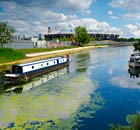
Bidding to host the Olympics, London sold itself partly on the basis that it would use the games to regenerate poor areas of the city. Previous Olympics have been criticised for creating "white elephant" sports facilities that are barely used afterwards.
Jacques Rogge, the president of the International Olympic Committee, said in March that London had "raised the bar" on regeneration, providing a "legacy blueprint" for future hosts. The games were praised by the IOC for a £1bn youth and community support strategy targeting 15- to 24-year-olds, an "International Inspiration" programme giving money to sporting charities around the world, and for awarding the majority of Olympic Park construction contracts to British companies, thus providing jobs.
The Olympics have resulted in a major regeneration of Stratford, where the games will take place, and improvements to nearby services, venues and public transport - including the expansion and upgrading of the Docklands Light Railway and the East London and North London lines (now rebadged as the "Overground"), and a high-speed service between St Pancras, Stratford and Ebbsfleet. There will also be a cable car between Greenwich peninsula and the Royal Docks, although this has been criticised for costing too much public money.
The Olympic Village will be converted into 3,600 flats, most of which will be "affordable", and there are plans for more homes to be built within the Olympic Park, which will be turned into an enormous public park, withwaterways cleaned and widened.
Almost all the Olympic venues either have a post-games future planned or have been built as temporary venues, and some events will take place at existing venues (the football tournament, for example, will be staged at several existing grounds around the country, while Wembley Arena will be used for badminton and gymnastics). After the games, the Aquatics Centre will be open to local people and will host swimming events. The Velopark will become a cycling centre. The Olympic Stadium will continue to be a sports and athletics centre, and will host the 2017 World Athletics Championships – but its permanent future role has not yet been decided. While these stadiums are all likely to be used after the Olympics, it is worth noting that they are all probably much bigger and more expensive than they would have been if they were purely designed for local needs.

No comments:
Post a Comment